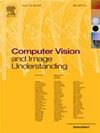结合光场空间超分辨率的退化估计
IF 3.5
3区 计算机科学
Q2 COMPUTER SCIENCE, ARTIFICIAL INTELLIGENCE
引用次数: 0
摘要
近年来,光场超分辨率(SR)技术取得了令人瞩目的成果。然而,在实践中,许多现有的方法受到假设固定退化模型(如双三次下采样)的限制,这阻碍了它们在具有复杂退化的现实场景中的鲁棒性。为了解决这一限制,我们提出了LF-DEST,一种有效的盲光场SR方法,该方法结合了显式退化估计来处理各种退化类型。LF-DEST包括两个主要部分:退化估计和光场恢复。前者同时估计低分辨率退化光场的模糊核和噪声图,后者根据估计的退化产生超分辨率光场。值得注意的是,我们引入了一个调制和选择性融合模块,智能地将退化表示与图像信息结合起来,有效地处理各种退化类型。我们在基准数据集上进行了广泛的实验,证明LF-DEST在光场sr的各种退化情况下都具有卓越的性能。实现代码可在https://github.com/zeyuxiao1997/LF-DEST上获得。本文章由计算机程序翻译,如有差异,请以英文原文为准。
Incorporating degradation estimation in light field spatial super-resolution
Recent advancements in light field super-resolution (SR) have yielded impressive results. In practice, however, many existing methods are limited by assuming fixed degradation models, such as bicubic downsampling, which hinders their robustness in real-world scenarios with complex degradations. To address this limitation, we present LF-DEST, an effective blind Light Field SR method that incorporates explicit Degradation Estimation to handle various degradation types. LF-DEST consists of two primary components: degradation estimation and light field restoration. The former concurrently estimates blur kernels and noise maps from low-resolution degraded light fields, while the latter generates super-resolved light fields based on the estimated degradations. Notably, we introduce a modulated and selective fusion module that intelligently combines degradation representations with image information, effectively handling diverse degradation types. We conduct extensive experiments on benchmark datasets, demonstrating that LF-DEST achieves superior performance across various degradation scenarios in light field SR. The implementation code is available at https://github.com/zeyuxiao1997/LF-DEST.
求助全文
通过发布文献求助,成功后即可免费获取论文全文。
去求助
来源期刊

Computer Vision and Image Understanding
工程技术-工程:电子与电气
CiteScore
7.80
自引率
4.40%
发文量
112
审稿时长
79 days
期刊介绍:
The central focus of this journal is the computer analysis of pictorial information. Computer Vision and Image Understanding publishes papers covering all aspects of image analysis from the low-level, iconic processes of early vision to the high-level, symbolic processes of recognition and interpretation. A wide range of topics in the image understanding area is covered, including papers offering insights that differ from predominant views.
Research Areas Include:
• Theory
• Early vision
• Data structures and representations
• Shape
• Range
• Motion
• Matching and recognition
• Architecture and languages
• Vision systems
 求助内容:
求助内容: 应助结果提醒方式:
应助结果提醒方式:


